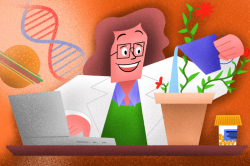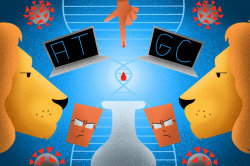Georgiy Zograf, PhD student at ITMO University
Silicon, the scientists’ yes-man
Nanophotonics is a science with many applications: amongst those are quantum dot displays, optical fibers, solar batteries, and many more; being involved with each of them is simply impossible. What I focus on is optically-induced heating.
We have two lasers in our laboratory. Laser #1 allows us to print nanoparticles. For one, we can make them from gold, silver, and silicon. There’s also the second laser, and its greatest advantage is that it is absolutely harmless to humans and can heat gold nanoparticles. How does this work? Gold is a metal, hence it has many free electrons that absorb light well, transforming it into heat. This way, we can use light to activate a “nanofurnace”, which is a hundred times smaller than any living cell. And biologists found it found a use in medicine, namely in treatment of cancerous tumours.

Say we have a poor little mouse. It has a tumour. Biologists somehow attach our nanoparticle to this tumour. Then we light it with laser #2, the particle becomes heated and burns the cancerous cells. Cool, isn’t it? Still, how do we control the temperature so that the particle won’t burn the healthy cells, as well? So, we need a nanothermometer. For this purpose, silicon is a good material… Still, you have to note that when a scientist says that the material is good, in 90% of instances they mean that it's available.
Well, I’m just joking. Silicon is anything but simple. It is used in different fields of science, from electronics to medicine. It’s like some scientists’ yes-man, which is ready to have a go at any problem, ours included. When light shines on silicon, it generates oscillations that we can detect and thus measure its temperature.
So, it seems as though our problem has been solved! But no, it's not that simple. When we tried to coat gold with silicon, silicon prevented gold from being heated. When we tried doing it vice-versa, the gold screened the oscillations from silicon. In the end, we tried using silicon only; it turned out that it heats well, and gives off oscillations, i.e. acts as both heater and thermometer at the same time.
Ilya Viksnin, Head of ITMO’s Multiagent Systems Laboratory
How ants, bees and pigeons help understand crowd behavior in emergencies
Each person is an individual, a personality. Yet, they start acting differently when there are lots of other people around: when in the subway, a scrum, or during an emergency. In this case, what we’ll be dealing with is an uncontrollable crowd.

We set an experiment where we tried to model a crowd by using swarm intelligence. This is a behaviour pattern that is intrinsic to ants. Let’s say we have an ant colony. Three ants find three different routes to a food source. These workers begin to carry the food to the hive, leaving a trail that other ants can use to navigate. Gradually, more and more ants would choose the shortest of the three routes. So, what will happen if it gets destroyed? Then, they would choose the second best route. This is how swarm intelligence manifests itself.
On a global scale, this is very smart, but a separate ant is rather stupid. So, we decided that the ants' behavioral pattern is just too simplistic to don it on humans. This is why we came up with three more rules: pass the impulse (if one tackles you on the subway, you tackle the next person), run faster than the others (if you know precisely where the rolling stairs are, you’ll be running there as fast as you can in order to outrun the others), and work your way to the centre (in case of an emergency, a human will instinctively force their way to the center of the crowd in order to be protected with a “meat shield”). Pigeons demonstrate similar behavior, for instance.

We had a hypothesis on human behavior in emergencies that we wanted to test by simulation. We decided to test it against a real case: the Lame Horse fire in Perm where there were 156 casualties. We used our model, and got similar results, give or take some ten casualties. From a scientific point of view, this is not much of a margin; still, if those are human lives we’re talking about, that’s huge. The margin has to be zero.
The drawback of using swarm intelligence here is that it implies that everyone behaves in a similar manner. So, we assumed that people need some leader they will follow - we can observe a similar mechanism in bees. They have scout bees who search for nectar, and then return to the hive to report this information to the foragers. People often have it the same way. We applied this model to the Lame Horse fire. People had to find the exits. How could this be done? We assumed that people would follow the lead of those they expect to know where the exits are even in case of emergency. So, we put a waiter near the stage, so that people would be able to see them. And that allowed to “save” 10 more people.
In any case, we couldn’t find a way to save everyone: the initial conditions just didn’t make it possible. This is why modeling of crowd behavior should be used for giving recommendations on the layout of particular facilities and organization of events still on design stage. Our simulator, for instance, can be used to model such events as the 2016 Atatürk Airport attack. Basically, we even had to restrict access to it so that it won’t be used by terrorists and the like.
Bogdan Borodin, member of the Optics Laboratory of the Ioffe Institute
How can graphene make electronics faster?
If you “tear off” an atom-thick strip from graphite, you’ll get graphene. Graphene has many useful properties; its Hall mobility is almost a hundred times higher than that of other materials, it’s transparent in the visible spectrum, flexible, and very sturdy. Also, graphene can be used in electronics.
In general, electronic circuit boards consist of two key components: transistors and conducting lines. Swiss scientists have already invented graphene transistors, which work a lot faster that regular ones. Still, such advantages come at a price.

The first problem is that the areas with electrons are constantly connected to the conducting lines. In other words, there is just no way to turn the transistor on and off. This can be solved by using the quantum confinement effect: if you cut a small piece from a graphene strip, then this area will act as a semiconductor, i.e. separate the conductivity zones and the zones where the electrons are. By applying voltage, one can control the transistor’s operation mode.
The other problem has to do with lithography, the process of creating the conductivity lines, as graphene is very thin and sensitive. Still, these lines can be created with the help of SPM (scanning probe microscope) lithography, which is what I focus on. The needle that is used for it is so thin that it becomes possible to modify the material on the atomic level.
Nikolai Panushin, PhD student at the Faculty of Biology of St. Petersburg State University
Why do genes constitute only 20% of the human genome?
What are genetic disorders? It is when some gene gets damaged, and this results in different malfunctions of the organism. Back in the 90’s, scientists decided to try replacing the damaged genes by injecting artificial chromosomes. Yet, for this method to work, they had to add lots of noncoding DNA to a gene. So, what is this seemingly irrelevant DNA, and why is it so important?
There are two types of DNA - coding and noncoding. In essence, DNA is a cookery book with recipes for all intents and purposes; it is from DNA that RNA is transcribed, which is then translated into proteins, and proteins are what makes us who we are. The core of the DNA consists of genes that encode proteins, but genes constitute only 20% of it! All the rest is noncoding DNA, which is exactly what I focus on.

So what’s the real deal with genomes and the number of genes? Does that really have much effect on one’s development? We all like to think that we, humans, are the pinnacle of creation. Still, our genome is quite moderate in terms of mammals: just three billion pairs of nucleotides and twenty thousand genes. A fruit fly’s genome is 30 times bigger, though it only has 15 thousand genes; a certain fish has a genome of 3,5 billion pairs of nucleotides, and 4 times more genes than us. Still, it is the amoeba that beats them all: it has 670 billions of pairs, and we are yet to decipher some of them.
So, what is it that defines the size of the genome? That would be the noncoding DNA sequences. I study the Alu sequence, which constitutes 10% of the genome, i.e. about a million of its copies. We are interested in studying how they operate when RNA is transcribed from them: it’s still not clear why and in what instances does that happen.
For instance, there’s the Ku70 protein that binds to Alu. This protein provides for DNA’s stability and can repair DNA breaks. If we deprive mice from it, they don’t live long: they begin to suffer from cancer and chromosomal instability. And we know that Alu binds to it well, which is a good reason for studying this sequence.

Following the results of the audience’s vote, Georgiy Zograf from ITMO University’s Faculty of Physics and Engineering was named this Science Slam’s winner. Amongst other speakers were art historian Maria Nazarova who spoke about the meaning behind the statues’ positioning, posture and color in Ancient Rome, as well as the event’s special guest - Alexey Pustovskikh from Gazprom Neft’s Scientific and Research Center who explained how mathematical calculations help enhance the efficiency of oil extraction.





